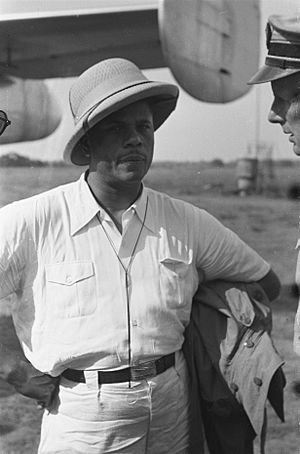Hubert Julian facts for kids
Quick facts for kids
Hubert Fauntleroy Julian
|
|
|---|---|
 |
|
| Personal details | |
| Born | 20 September 1897 Port of Spain, Trinidad |
| Died | 19 February 1983 New York City, US |
| Military service | |
| Allegiance | |
| Years of service | 1935 –1941 |
| Rank | Colonel |
| Unit | Arbegnoch |
| Battles/wars | Second Italo-Ethiopian War |
Hubert Fauntleroy Julian (born September 21, 1897 – died February 19, 1983) was a brave Trinidadian pilot. He was known for his daring flights and was nicknamed "The Black Eagle". Julian was a pioneer in aviation, meaning he was one of the first to do many things in flying.
Contents
Early Life and First Flight
Hubert Fauntleroy Julian was born in Port of Spain, Trinidad, in 1897. His father managed a cocoa farm. Young Julian first saw an airplane in 1913. A pilot named Frank Boland performed a flying show. Sadly, the plane crashed, and Boland died. This event deeply affected Julian.
After World War I, Julian left Trinidad for Canada. In November 1920, he flew for the first time. It was a fun ride with a famous Canadian pilot, Billy Bishop. Soon after, Julian invented a special "Aeroplane Safety Appliance." He even got a patent for it!
Becoming "The Black Eagle" in the 1920s
In 1921, Julian moved to Harlem, New York. There, he met Marcus Garvey, a leader who inspired many Black people. Julian joined Garvey's group, the Universal Negro Improvement Association. He started calling himself "Lieutenant Hubert Julian." He even had a fake military uniform made!
On September 3, 1922, Julian did his first parachute jump. This happened at Curtiss Field on Long Island. Another famous pilot, Bessie Coleman, also flew that day. Julian made another jump later that year.
He then teamed up with pilot Clarence Chamberlin. Chamberlin taught Julian how to really fly an airplane. They performed amazing stunts together. Julian would parachute over Harlem, sometimes wearing a bright red jumpsuit. Once, he even played "Runnin' Wild" on a saxophone while falling! These stunts earned him the nickname "The Black Eagle of Harlem." In October 1923, he parachuted again over Harlem, playing a gold-plated saxophone.
Dreaming of a Transatlantic Flight
In 1924, Julian and Chamberlin planned a huge flight. They wanted to fly across the Atlantic Ocean to Liberia in Africa. Their route included stops in Florida, the Caribbean, and Brazil. Julian bought an old seaplane and named it the Ethiopia.
On July 4, thousands of people gathered to watch him take off. Julian boarded his plane, ready for the adventure. But just minutes after taking off, he realized something was wrong. One of the plane's floats had filled with water. The plane became unbalanced. Julian lost control and crashed into Flushing Bay.
Julian tried two more times to fly across the Atlantic. One attempt ended when someone damaged his plane's wings. The last attempt was led by a senator. But then Amelia Earhart successfully crossed the Atlantic. Julian felt that his dream was no longer unique, so he stopped the project.
Adventures in the 1930s
In the early 1930s, Julian visited the Ethiopian Empire three times. During his second visit, he accidentally crashed Emperor Haile Selassie's favorite plane. The emperor asked Julian to leave.
But Julian returned to Ethiopia when the Second Italo-Ethiopian War was about to begin. He joined the military to help defend the country. During this time, he had a disagreement with another pilot, John C. Robinson. When it became clear that Italian forces would win, Julian left Ethiopia. He returned later as a volunteer in the East African Campaign of 1940–41.
Back in the United States, Julian flew with William Powell's Five Blackbirds. This was an all-Black flying group that performed shows. He also flew for important people like Father Divine. Julian even tried producing films with director Oscar Micheaux. He helped fund two movies: Lying Lips and The Notorious Eleanor Lee.
World War II and Beyond
During the Winter War between Finland and the Soviet Union, Julian went to Finland. He was one of many American volunteers who wanted to help. He stayed for several months but did not see any fighting. He then returned to the United States.
Julian learned that Adolf Hitler and Hermann Göring were saying bad things about people of color. The Black Eagle bravely challenged Göring to an aerial duel! He offered to fight him in the sky above the English Channel. Göring never replied, but Julian was praised for his courage.
When the attack on Pearl Harbor brought the United States into World War II, Julian joined the military. He was in his 40s at the time. He served for less than a year and became an American citizen. He left the military with the rank of private first class.
Later Years and Legacy
After World War II, Julian became a licensed arms dealer. He sold weapons to different governments. He was briefly held by United Nations forces and spent four months in jail. After this, he retired and returned to the United States.
In his retirement, Julian met famous people like Muhammad Ali. He also appeared on popular TV shows like The Merv Griffin Show and The Tonight Show. Hubert Julian died in 1983 and was buried in Calverton National Cemetery in New York.
Personal Life
Hubert Julian was married three times. His first marriage to Edna Powell lasted only a few years. His second and longest marriage was to Essie Gittens, whom he knew from Trinidad. They raised Essie's young orphaned cousin, Olga, as their own daughter. After Essie passed away, Julian married Doreen. They had Julian's only biological child, Mark Anthony Bernard Julian, in 1971.
Images for kids
See also
 In Spanish: Hubert Julian para niños
In Spanish: Hubert Julian para niños


